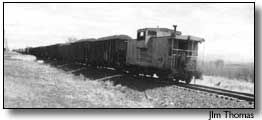|
July 10, 2001
By Jim Thomas Journal Sports Editor It was sunny and warm as Bob Stalcup, Dick Glass, Mike Latcher, young Lloyd Husted III, and I went railfanning (taking pictures and just plain watching trains roll by) headed for Thoreau and Gallup, N.M., for a day by the tracks. So with camera in hand (no tripod, which was a mistake), we loaded in Latcherís car and drove south of Farmington on N.M. 371 (Vietnam Veterans Memorial Highway) to Thoreau (pronounced like "through") for the Burlington Northern Santa Fe double-track main line. Some 100-plus trains run a day. We were there eight hours and we saw 27 roll by (Amtrak, plus mainly intermodal freights, piggy backs, and only a few mixed). Latcher brought his videocamera, Husted brought his parentís digital camera. And Stalcup and I had our 35mm cameras. Glass had his trusty notebook in which he fills in car numbers, type of cars, type of motive power and types of loads. The main thing to consider, especially for the (35mm and digital) photographers and videographers, are what their intentions are for making images. Railfans should ask themselves what they are wanting, such as to document the entire BNSF diesel roster or just trying to shoot a train passing by trying to illustrate a particular point or just trying to create a well-crafted interesting image. With that thinking at hand, we stopped just east of Thoreau. Husted just plain had fun working his parentís digital camera. He took shot after shot. With each shot he took, he just seemed to get better and better with each image. Stalcup and I focused on engines and cars that particular day. But we werenít trying to necessarily fill our photo files, but just plain have fun. Early in the morning, with some other railfans who had traveled from back East, we had some excitement. There was a certain tingle turned to full-blown excitement when an Amtrak rolled by. But a few minutes later a nice deputy came by to see what we were doing as the engineer had heard, from a pervious engineer, that we were on the right-of-way. Actually, we were not on a right-of-way, but at a road crossing. This is a good spot because a railfan can near the tracks without being on the right-of-way. A few minutes later, a big BNSF SD80MAC wearing new BNSF paint came whizzing right by. I took a shot of the engine since Iím a locomotive guy. This was the shot, as if thereís only one way to see something. I mean, you can whip out your 80mm lens and take a roster shot, the light is perfect, you can see all the details that rivet-counters and model railroaders like. Iím a model railroader, too, so I like to shoot shots showing details. We headed a few miles west towards Gallup on I-40 to stop at another spot. Within a few minutes, Stalcupís scanner burst with radio chatter. More trains headed our way. Husted and I walked down along the tracks to a trestle. I hunched down in the dirt and pondered my next shot. If I wanted to do something other than my usual action shot, Iíd have to take my own advice and think differently. In a few minutes, we turned around and we heard the grade crossing bell sound. I took a step back, focused on a nearby bush, and threw the train out of focus in the background. Then I opened the lens aperture for minimum depth of field, another way of assuring that only the bush would be in focus. I waited until the blur of the train appeared in the viewfinder, then snapped the shutter. The relatively short train rumbled past, a string of multicolored boxcars, hoppers and bulkhead flats as I recall. But I got the shot I wanted. Husted took several shots with the digital. He focused on just the engine that time. We headed to a bridge over the railroad tracks. We took some shots of a train which had just finished loading oil. I got several shots of the engine from the front of the train (high and above). I took several of it as it passed underneath the overpass. We then headed for Stalcupís favorite train watching spot near Second Street in Gallup. We all sat on a wall, right near the train yard. We stayed there for several hours before leaving town. Gallup is about a two-and-half hour drive south from Cortez on U.S. Highway 666. I crossed the tracks to take a shot of abandoned tracks heading into a lumber yard. I thought this would be something I might want to model one day. Those who have seen my model railroad (the HO-scale Four Corners and Pacific) know I have several sections of abandoned track on my layout.
All-in-all, it was a good day for railfanning. Of course, those who donít like the big, modern trains of today can easily step into the 1880s by railfanning at Durango (Durango-Silverton Narrow Gauge Railroad) or go to Chama, N.M., (Cumbres and Toltec Narrow Gauge Railroad). Good railfanning opportunities for those who like and can appreciate steam-powered locomotives and old railcars. |
||||
|
Copyright © 2001 the Cortez Journal.
All rights reserved. |

